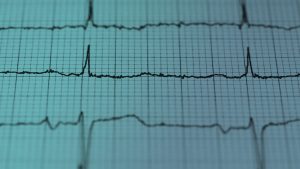
Scientists began the journey to modern electrocardiography in 1873 thanks to the capillary electrometer—which was invented by Gabriel Lippmann to detect electric current. The machine consisted of metal wires and a tube with one thick end and one thin end that was filled with mercury and sulfuric acid. Using the electrometer, British physiologist Augustus Desiré Waller developed the first EKG machine in 1887. It consisted of a capillary electrometer that was affixed to a projector. Electrodes were placed on the patient’s chest and back; when electrical current entered the tube, the mercury leapt up a short distance. The movement of the mercury, which represented the heart’s electrical pulses, was projected onto a photographic plate, a flat sheet of metal on which an image was recorded.






